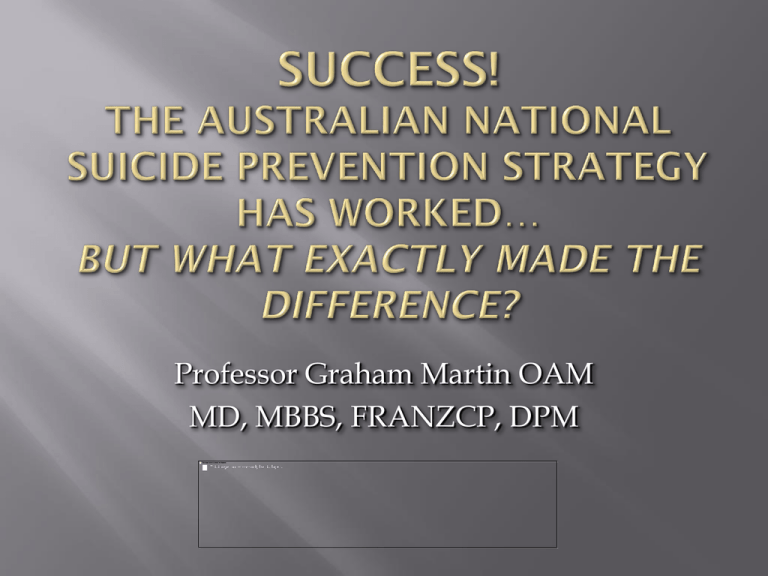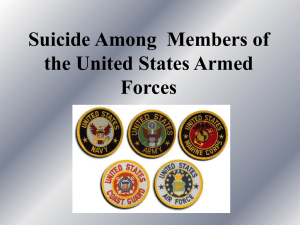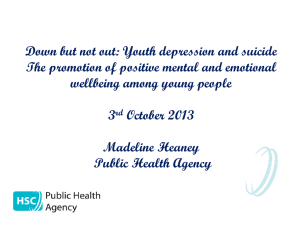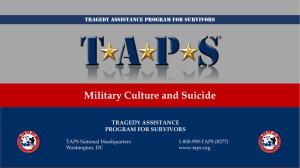
Professor Graham Martin OAM
MD, MBBS, FRANZCP, DPM
Nearly
1 million
people
in 2007
(a) Males
60
50
50
40
40
30
30
20
20
10
10
0
0
(b) Females
No. of years pre-strategy
54
51
48
45
42
39
36
33
30
27
24
21
18
15
12
9
6
3
0
3
6
9
12
15
18
21
54
51
48
45
42
39
36
33
30
27
24
21
18
15
12
9
6
3
0
3
6
9
12
15
18
21
Rate per 100,000
.
60
No. of years pre-strategy
No. of years post-strategy
All ages
15-24 years
No. of years post-strategy
(a) Males
60
50
50
40
40
30
30
20
20
10
10
0
0
(b) Females
No. of years pre-strategy
54
51
48
45
42
39
36
33
30
27
24
21
18
15
12
9
6
3
0
3
6
9
12
15
18
21
54
51
48
45
42
39
36
33
30
27
24
21
18
15
12
9
6
3
0
3
6
9
12
15
18
21
Rate per 100,000
.
60
No. of years pre-strategy
No. of years post-strategy
All ages
15-24 years
No. of years post-strategy
(a) Males
60
50
50
40
40
30
30
20
20
10
10
0
0
(b) Females
No. of years pre-strategy
54
51
48
45
42
39
36
33
30
27
24
21
18
15
12
9
6
3
0
3
6
9
12
15
18
21
54
51
48
45
42
39
36
33
30
27
24
21
18
15
12
9
6
3
0
3
6
9
12
15
18
21
Rate per 100,000
.
60
No. of years pre-strategy
No. of years post-strategy
All ages
15-24 years
No. of years post-strategy
(a) Males
60
50
50
40
40
30
30
20
20
10
10
0
0
(b) Females
No. of years pre-strategy
54
51
48
45
42
39
36
33
30
27
24
21
18
15
12
9
6
3
0
3
6
9
12
15
18
21
54
51
48
45
42
39
36
33
30
27
24
21
18
15
12
9
6
3
0
3
6
9
12
15
18
21
Rate per 100,000
.
60
No. of years pre-strategy
No. of years post-strategy
All ages
15-24 years
No. of years post-strategy
(a) Males
60
50
50
40
40
30
30
20
20
10
10
0
0
(b) Females
No. of years pre-strategy
54
51
48
45
42
39
36
33
30
27
24
21
18
15
12
9
6
3
0
3
6
9
12
15
18
21
54
51
48
45
42
39
36
33
30
27
24
21
18
15
12
9
6
3
0
3
6
9
12
15
18
21
Rate per 100,000
.
60
No. of years pre-strategy
No. of years post-strategy
All ages
15-24 years
No. of years post-strategy
ABS,
2007
3303.0
SUICIDES AS A PROPORTION OF ALL DEATHS
45
40
30
25
20
15
10
5
Recorded rates
Scenario 1
Scenario 2
0
1979
1981
1983
1985
1987
1989
1991
1993
1995
1997
1999
2001
2003
2005
Rate per 100,000
35
Revised suicide
rates under
both scenarios
did not
significantly
differ from
recorded
suicide rates
based on 95%
confidence
intervals.
Australian Suicide Rates
15-24 yrs, per 100,000 (ABS)
35
30
25
20
15
10
5
0
1968
70
72
74
76
78
80
82
84
86
88
90
92
94
96
98
2000
2002
2004
2006
Big changes have occurred over 12 years
The changes in youth suicide could be
described as dramatic (55% reduction)
They appear to be real, despite any possible
misclassifications
It is tempting to suggest that the National
Strategy ± state strategies may have had
some impact
“The recent sudden turnaround in Australian
young male suicide trends and its extent
appears to preclude explanations centering
on slow-moving social indices traditionally
associated with suicide, or on possible
cohort effects.
This sudden decrease has occurred mainly in
non-impulsive means, and at the same time
has broken a long-standing secular link
between 20-24 yr male suicide and
unemployment, lending plausibility to the
case for the NYSPS having had an impact on
young male suicide in Australia.”
There are 2 issues within the rates which
need
to be addressed:
•Rural and Remote Status, and
•Socio-economic Status
Australian suicide rates by urban-rural
residence, 1979-2003 (rate per 100,000)
Page A, Morrell S, Taylor R, Dudley M, Carter G. Further increases in rural suicide in young Australian adults:
Secular trends 1979-2003. Soc Sci Med. 65(3): 442-53.
Australian suicide rates by low, middle &
high SES, 1979-2003 (rate per 100,000)
Page A, Morrell S, Taylor R, Carter G, Dudley M. Divergent trends in suicide by socio-economic status in
Australia. Soc Psychiatry Psychiatr Epidemiol 2006;41(11):911-7.
Harding et al., 2006. NATSEM
Male
Suicide
Accidental
Poison.
Assault
Female
Total
Rank
% All deaths
OR
(X60-X84)
2.8
Indig Aust
74
29
103
5
4.2
Non-indig
1,588
444
2,032
14
1.5
(X40-X49)
3.75
Indig Aust
24
13
37
14
1.5
Non-indig
408
156
564
39
0.4
(X85-Y09)
15
Indig Aust
22
15
37
14
1.5
Non-indig
100
62
162
51
0.1
This brings us to the crucial issue of the origins
of suicide.
On the one hand we know that suicide is a
behaviour related to mental illness and
occurring at the end point of despair
On the other hand, there are social and cultural
conditions which contribute to the development
of mental health problems and despair
Support high risk through Suicide Prevention Centre (I)
Post-discharge contact with psychiatric inpatients (I)
(3%)
Education for GPs (II)
Drug treatments and ECT (II)
Improved Prescribing (eg SSRIs) (III) (4%)
Suicide Prevention Centres (III)
Group treatment for depressed and suicidal (III)
Media restrictions on reporting (III)
Legislation of Drugs (eg Barbiturates) (III)
“National suicide prevention strategies have
been proposed despite knowledge deficits
about the effectiveness of some common key
components
the most promising interventions are physician
education, means restriction, and gatekeeper
education. Many universal or targeted
educational interventions are multifaceted, and
it is not known which components produce the
desired outcome”
National Strategies are successful if they provide…
communication program to the whole population
education for relevant groups (‘gatekeepers’)
reduced access to means (bridges, firearms, etc)
a strategy on drugs and alcohol
a critical mass of clinical services with relevant
and sufficient highly trained professionals
improved services managing suicidal people, as
well as improved linkages with the community
proper evaluation with a formative approach
a strategy for Indigenous peoples
A large number of people at small risk may give
rise to more cases of disease than a small
number of cases at high risk
A population strategy of prevention is necessary
where risk is widely diffused through the
whole population.
Rose, Geoffrey, The strategy of preventive medicine. Oxford University
Press, 1992
Population
Mortality
threshold
Move
population
risk
Low
High
Suicide risk
Mental Health Promotion
70+ Projects funded, covering:
Primary prevention and cultural change
Early Intervention
Crisis Intervention
Treatment, support and postvention
Access to Means/Injury prevention
$31m+ (over 4 years)
National Advisory Council
Valuing Young Lives, Penny Mitchell, Australian Institute of Family Studies, 2000
Process Indicators are available for:
Professional training (eg in parenting programs)
Gatekeeper training (eg KYA & GPs - 7% or 3500)
Curricula for schools
Media Resource Kit
Training for Telephone Counsellors
Crisis/Hospital Emergency Departments
Community Development projects
Valuing Young Lives, Penny Mitchell, Australian Institute of Family Studies, 2000
Impact Indicators
Clinical programs (“some evidence”)
Population level impacts (“no evidence exists”)
Outcome Indicators (only a few available)
Clinical programs
3 programs in mental health services
1 program in Accident & Emergency
Parenting programs
Telephone counselling services
Programs for marginalised youth
Valuing Young Lives, Penny Mitchell, Australian Institute of Family Studies, 2000
The Evaluation Experience, Jonine Penrose-Wall et al.,
NYSPS Evaluation Working Group, 2000
Many, if not most, of the smaller programs
simply completed their course, were not
refunded, and their long term impact at a
local level is unknown
A few programs acted as springboards for
larger, better programs
Some of the larger programs have lasted to
the present day and continue to have
impact at a national level
Achieving the Balance (Suicide
Prevention Australia, 1998)
negotiated widely with Media to
provide clear, relevant advice.
Then, a new National Media &
Mental
Health Committee commissioned:
major literature review
1-year prospective research
revised guidelines
www.MindFrame-Media.info
In the 18 years before the 1996 gun law reforms,
there were 13 mass shootings in Australia, and
none in the 10.5 years afterwards.
Declines in firearm-related deaths before the law
reforms accelerated after the reforms for total
firearm deaths (p 0.04), firearm suicides (p
0.007) and firearm homicides (p = 0.15), but not
for unintentional firearm deaths, which
increased.
No evidence of substitution effect for suicides or
homicides was observed.
S Chapman, P Alpers, K Agho, M Jones, Injury Prevention 2006;12:365–372
MALE
0-14
FEMALE
15-24
0-14
Amitryptiline
1727
Dothiepin
Doxepin
15-24
2198
199
Fluoxetine
724
41
178
852
63
2134
Other
27,292
4083
4940
2845
Total
27,491
7,134
5044
7417
ABS, 1999
Total: 47,086
704,200
young people used psychotropics
41,548 (5.9%) Citalopram
25,351 (3.6%) Paroxetine
= 18.5% 130,277
51,407 (7.3%) Sertraline
Total SSRI
11,972 (1.7%) Other SSRI
prescriptions
20,422 (2.9%) Venlafaxine
12,676 (1.8%) Tricyclics
12,676 (1.8%) Other Antidepressant
10.1% Anxiolytics
83.5% other including 69.2% Vitamins and Minerals
Table 15, page 36 Ausstats 2005
No change in rates of depression between 1995
and 2005 (ABS: Mental & Behavioural Problems,
2005)
More children <17 years were homeless and
sought help through Supported Accommodation
Assistance Program (SAAP) (AIHW)
Reported cases of child abuse rose from 91,734 to
115,471 during the period 1995/6-2000/1
Number of children placed in out of home care
rose from 14,078 to 18,241 during the period 1997 2001
129/12,006
1.1%
•Of those who self-injured in the month prior
to survey, 48.4% also experienced suicidal
ideation in the month compared to only 7.7%
of those who did not self-injure (OR 11.25,
95% CI 7.88-16.06).
•However, only 14 of 133 one-month selfinjurers (10.5%) also reported a suicide
attempt in the previous 12 months. Despite
the small number, the rate is high compared
to non-self injurers (33 of 11,873, 0.28%) (OR
41.60, 95% CI 21.32 – 81.18).
Meta-analysis of 331 Coronial Studies
65 studies met criteria;
Subject N = 19,347;
Alcohol discovered in 81.7% suicides;
22.7% intoxicated at time of death
(Blood Alcohol Concentration ≥ 100mg/dL
Smith, Branas and Miller, 1999
DENMARK (1916-17) prices up, suicide down
Skog, 1993
RUSSIA (1984-88) restrictions on Vodka sales
following Perestroika led to reduced suicide
Wasserman et al., 1994
UNITED STATES (1970-89) states with lower
spirit consumption have reduced suicide
Gruenewald et al., 1995
ICELAND (1989) legalization of strong beer /
reduced spirits / decrease in suicide rate
Lester 1999
Strong association between drinking and
attempts in 13 year olds (Time 1) (chi-square
220.5, p<0.0001)
15.9% of those drinking >1/week claimed
an attempt, compared to 0.9% for those
claiming never (Odds ratio 17.3).
357 deaths attributed to opioids in 2004, ages 15
to 54 years.
Males comprised 78% of the deaths
Ten-year breakdown of deaths attributed to
opioids in 2004 showed:
43% were among the 25-34 year age group,
28% in the 35-44 age group,
18% in the 45-54 age group,
10% 15-24 age group.
Degenhardt et al.,2006.
National Drug and Alcohol Research Centre.
Non-suicidal patients can all defend notions of
continuity of the self
80% of suicidal patients can mount no
argument about continuity (self or other)
Failures in ‘self’ continuity ‘predict’ suicide risk
(Ball & Chandler, 1989; Lalonde & Ferris, 2001)
Euro-American culture & Essentialism
Self & knowledge are individualistic
Aboriginal culture & Narrative
Self is relational
Knowledge is communal/cultural product
Identity is defined by Place (on the land), and
is fashioned out of materials made available
by culture
Lalonde 2006
Courtesy: Michael Chandler University of British Columbia
Courtesy: Michael Chandler University of British Columbia
In a very recent study (Patrao, Page, Martin unpublished paper ex a masters thesis)
Postcodes with access to 6 NYSPS programs or
more had a significantly lower young male
suicide rate (34.5 per 100,000) compared to
areas with little activity (38.8 per 100,000)
Relative risk of suicide in highest SES group
with greatest level of preventive activity was
0.91 (0.81-1.02) compared to the lowest SES
group with no activity.
We are currently reworking the analysis…
When designing programs we need a balance
between increasing protective factors and
reducing risks
Universal approaches to improve ‘resilience’ and
‘connectedness’
We need to raise awareness about issues, alert
people to avenues for care, and provide tools to
further their skills
We need clear and supported pathways to care
I offer you an example…
Constructing a Healthy
Industry in Queensland
‘Mates in Construction’
A suicide prevention
and social capacity
building program, with
a vision for resilient &
resourceful apprentices
and workers,
confidently facing life
challenges.
‘Mates in Construction’
What does it do?
• General awareness training about mental health
problems and the problem of suicide (ASIST etc)
• Life Skills Toolbox raises awareness of health and
wellness, provides strategies, encourages access to
care
• ‘Connectors’ provide links to existing services
• Provides an access line for crisis management and
referral
• Deals with serious problems immediately
“I was providing General Awareness
Training to a group of apprentices
when I noticed one of them affected
by the presentation.
In the break he said – “John, I was ticking
all the boxes! All that stuff about the
signs of suicide fits one of my mates. I
think we might stand at his grave one
day and say – If only we had
known!”.
We contacted the young man’s parents.
They confirmed he had been thinking
about suicide, and decided on when
and where to do it as well…
See this young apprentice may just have
saved a life; it just does not get much
better than that!”
Client Numbers
Number
New
182
Archived
105
Active
77
%
Age
15-24
13
14
25-34
24
25
35-44
33
34
45-55
21
22
56+
5
5
OzHELP Problem LIST
Cases
%
Relationship
63
11
Financial
55
9
Family
54
9
Work related
40
7
Alcohol
35
6
Legal
32
5
Personal Injury/Health
32
5
Anger
32
5
Drug
31
5
Suicide Ideation
30
5
Employment
28
5
Mental Health Problem (diagnosed)
23
4
Fatality/Grief
20
3
Suicide Intervention
13
2
A part of me still believes in the importance of
reducing risk factors - unemployment, socioeconomic exclusion, abuse, depression.
But the programs from the NYSPS which have
endured, and have continued to have long term
impact, are about resilience, connectedness,
increased awareness, clear information for
when crises occurs, and help-seeking.
We need to develop an attributable impact
ratio (AIR) (cf. attributable risk or protective
fraction) to get a clearer handle on just what
works in the long term.










